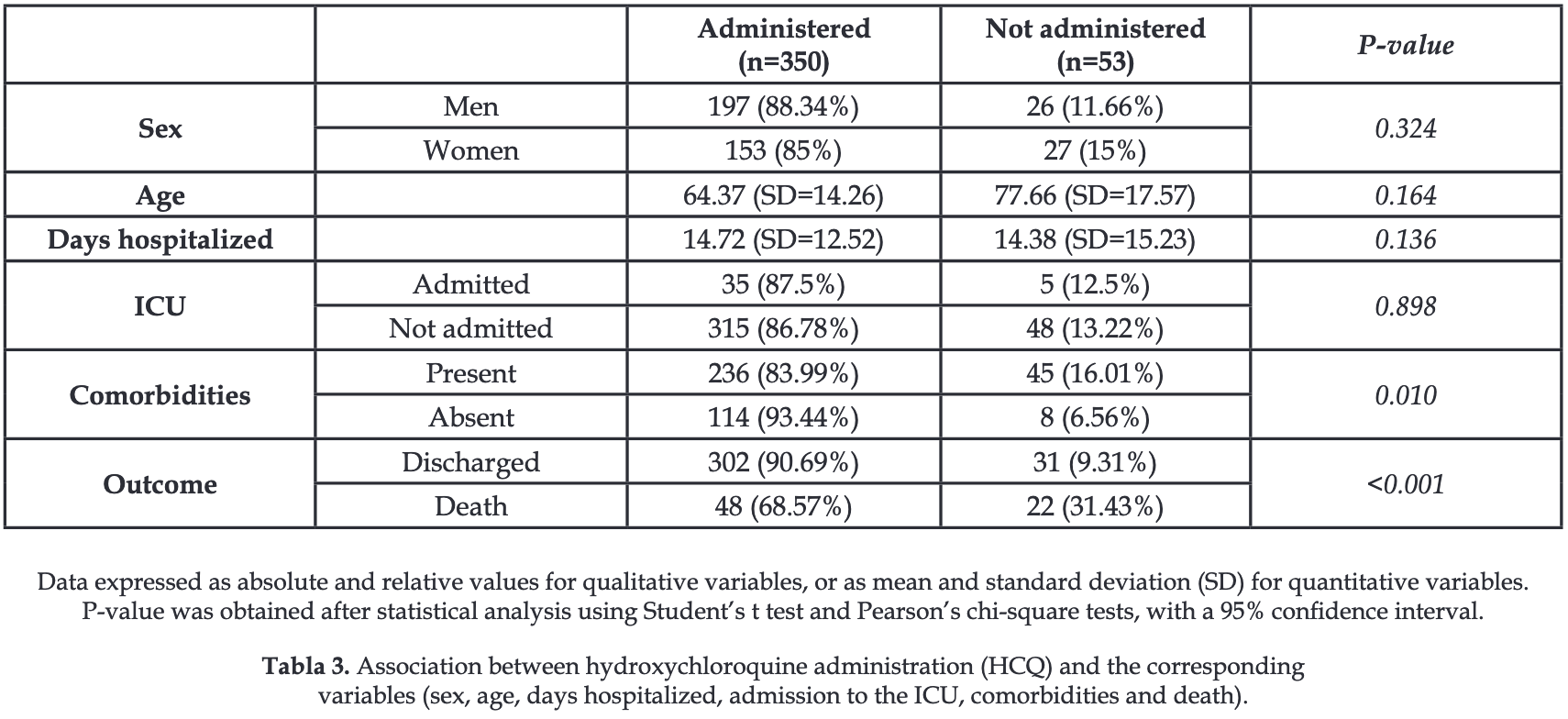Hydroxychloroquine and Tocilizumab in the Treatment of COVID-19: A Longitudinal Observational Study
Asensi -Gómez, ; Carbajo-García, ; Cobano-Jiménez, Juan Luis, ; Lenker-Andrade, ; Vázquez- Delgado, ; Vivas-Del-Torno, ; García-Molina, ; Flor-Cremades, María Consuelo, ; Muñoz-Rojas, ; Moleón-Moya
Objectives The objective of this study is to evaluate the use of hydroxychloroquine and tocilizumab at the beginning of the COVID-19 pandemic and to describe the profile of patients who received these treatments.
Method The medical records of 403 patients admitted for COVID-19 from March 1 to April 15, 2020 at the San Cecilio University Hospital (Granada, Spain) were analyzed. The data collected included sex, age, days hospitalized, previous pathologies and/or treatments, possible outcomes and drugs administered at the hospital. Student's t-test and Pearson's chi-square tests were used as statistical parameters to estimate the possible associations between the defined variables.
Results Patients with a mean age of 66 years (standard deviation = 15.38), were hospitalized for an average of 15 days (standard deviation = 12.89). The ICU admission rate was 9.93 %, and the death rate added up to 17.37 % of the total number of patients. During the first wave of the pandemic, hydroxychloroquine was administered to the majority of hospitalized patients, while tocilizumab was restricted to the more severe cases.
Conclusions The results showed two distinct trends in the use of the drugs studied. Tocilizumab was administered to a small number of patients, mainly those with longer length of stay or with complications. Hydroxychloroquine was administered independently of the initial characteristics of patients, especially those who presented comorbidities or took multiple medications.
Conflicts of interest The authors of this paper declare no conflicts of interest.
References
Arcos, Puche, Vera, Controversy regarding ACE inhibitors/ARBs in Covid-19, Rev Esp Cardiol (Engl Ed)
Awadasseid, Wu, Tanaka, Zhang, Initial success in the identification and management of the coronavirus disease 2019 (COVID-19) indicates human-to-human transmission in Wuhan, China, Int J Biol Sci
Bansal, Goyal, Cusick, Lahan, Dhaliwal et al., Hydroxychloroquine: A comprehensive review and its controversial role in coronavirus disease 2019, Ann Med
Campochiaro, Della-Torre, Cavalli, Luca, Ripa et al., Efficacy and safety of tocilizumab in severe COVID-19 patients: a single-centre retrospective cohort study, Eur J Intern Med
Capra, Rossi, Mattioli, Romanelli, Scarpazza et al., Impact of low dose tocilizumab on mortality rate in patients with COVID-19 related pneumonia, Eur J Intern Med
Cheong, Bartell, Peeraphatdit, Mosli, Gastrointestinal and liver manifestations of COVID-19. Saudi J Gastroenterol Off, J Saudi Gastroenterol Assoc
Colaneri, Bogliolo, Valsecchi, Sacchi, Zuccaro et al., Tocilizumab for treatment of severe COVID-19 patients: preliminary results from SMAtteo COvid19 REgistry (SMACORE), Microorganisms
De Brouwer, Van Veldhuisen, De Boer, Surviving the first COVID-19 wave and learning lessons for the second, Eur J Heart Fail
Dubert, Visseaux, Isernia, Bouadma, Deconinck et al., Case report study of the first five COVID-19 patients treated with remdesivir in France, Int J Infect Dis
Fontana, Alfano, Mori, Amurri, Tei et al., Covid-19 pneumonia in a kidney transplant recipient successfully treated with tocilizumab and hydroxychloroquine, Am J Transplant
Fravel, Ernst, Drug Interactions with Antihypertensives, Curr Hypertens Rep
Gallego, Codorniu, Cabrero, The impact of COVID-19 on the elderly dependent population in Spain with special reference to the residential care sector, Ciência & Saúde Coletiva
Gautret, Lagier, Parola, Meddeb, Mailhe et al., Hydroxychloroquine and azithromycin as a treatment of COVID-19: results of an open-label non-randomized clinical trial, Int J Antimicrob Agents
Gupta, Wang, Hayek, Chan, Mathews et al., Association between early treatment with tocilizumab and mortality among critically ill patients with COVID-19, JAMA Intern Med
Gutiérrez-Abejón, Tamayo, Garcia, Álvarez, Herrera-Gómez, Clinical Profile, Treatment and Predictors during the First COVID-19 Wave: A Population-Based Registry Analysis from Castile and Leon Hospitals, Int J Environ Res Public Health
Huang, Wang, Li, Ren, Zhao et al., Clinical features of patients infected with 2019 novel coronavirus in Wuhan, China, Lancet
Ibáñez, Martinez, Valenzuela, Silva, Valenzuela, Hydroxychloroquine and chloroquine in COVID-19: should they be used as standard therapy?, Clin Rheumatol
Klopfenstein, Zayet, Lohse, Balblanc, Badie et al., Tocilizumab therapy reduced intensive care unit admissions and/or mortality in COVID-19 patients, Med Mal Infect
Lemmon, Chapman, Malcolm, Kelley, Shaw et al., Beyond the First Wave: Consequences of COVID-19 on High-Risk Infants and Families, Am J Perinatol
Luo, Liu, Qiu, Liu, Liu et al., Tocilizumab treatment in COVID-19: a single center experience, J Med Virol
Miranda, Silva, Capita, Alonso-Calleja, Igrejas et al., Implications of antibiotics use during the COVID-19 pandemic: present and future, J Antimicrob Chemother
Pereira, Challenges and cares to promote rational use of chloroquine and hydroxychloroquine in the management of coronavirus disease 2019 (COVID-19) pandemic: a timely review, J Toxicol Environ Heal Part B
Risch, Early outpatient treatment of symptomatic, high-risk COVID-19 patients that should be ramped up immediately as key to the pandemic crisis, Am J Epidemiol
Rubio, Castillo, De, De La Hera Fernández, Arrabal et al., Effectiveness of corticoid pulses in patients with cytokine storm syndrome induced by SARS-CoV-2 infection, Med Clínica (English Ed
Russell, Millar, Baillie, Clinical evidence does not support corticosteroid treatment for 2019-nCoV lung injury, Lancet
Samaee, Mohsenzadegan, Ala, Maroufi, Moradimajd, Tocilizumab for treatment patients with COVID-19: Recommended medication for novel disease, Int Immunopharmacol
Schiffrin, Flack, Ito, Muntner, Webb, Hypertension and COVID-19
Sciascia, Aprà, Baffa, Baldovino, Boaro et al., Pilot prospective open, single-arm multicentre study on off-label use of tocilizumab in severe patients with COVID-19, Clin Exp Rheumatol
Stone, Frigault, Serling-Boyd, Fernandes, Harvey et al., Efficacy of tocilizumab in patients hospitalized with Covid-19, N Engl J Med
Xu, Han, Li, Sun, Wang et al., Effective treatment of severe COVID-19 patients with tocilizumab, Proc Natl Acad Sci
Zhou, Dai, Tong, COVID-19: a recommendation to examine the effect of hydroxychloroquine in preventing infection and progression, J Antimicrob Chemother
